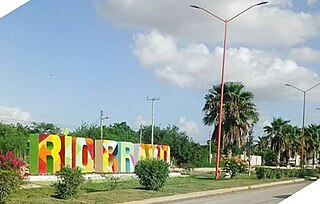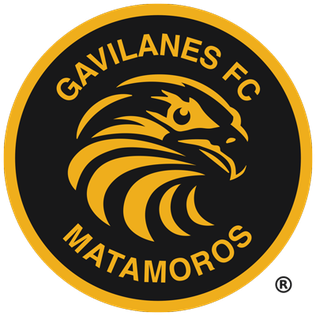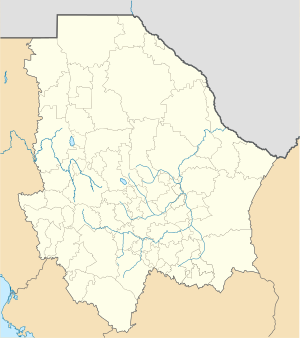
Matamoros, officially known as Heroica Matamoros, is a city in the northeastern Mexican state of Tamaulipas, and the municipal seat of the homonymous municipality. It is on the southern bank of the Rio Grande, directly across the border from Brownsville, Texas, United States. Matamoros is the second largest city in the state of Tamaulipas. As of 2016, Matamoros had a population of 520,367. In addition, the Matamoros–Brownsville Metropolitan Area has a population of 1,387,985, making it the 4th largest metropolitan area on the Mexico–US border. Matamoros is the 39th largest city in Mexico and anchors the second largest metropolitan area in Tamaulipas.

Bartolomé Maximiliano Moré Gutiérrez, better known as Benny Moré, was a Cuban singer, bandleader and songwriter. Due to his fluid tenor voice and his great expressivity, he was known variously as El Bárbaro del Ritmo and El Sonero Mayor. Moré was a master of the soneo – the art of vocal improvisation in son cubano – and many of his tunes developed this way. He often took part in controversias with other singers like Cheo Marquetti and Joseíto Fernández. Apart from son cubano, Moré was a popular singer of guarachas, cha cha cha, mambo, son montuno, and boleros.

The Second Mexican Empire, officially the Mexican Empire, was a constitutional monarchy established in Mexico by Mexican monarchists in conjunction with the Second French Empire. The period is sometimes referred to as the Second French intervention in Mexico. French Emperor Napoleon III, with the support of the Mexican conservatives, clergy, and nobility, established a monarchist ally in the Americas intended as a restraint upon the growing power of the United States. It has been viewed as both an independent Mexican monarchy and as a client state of France. Invited to become emperor of Mexico by Mexican monarchists who had lost a bloody civil war against Mexican liberals was Austrian Archduke Maximilian, of the House of Habsburg-Lorraine, who had ancestral links to rulers of colonial Mexico. His ascension to the throne was then ratified through a fraudulent referendum. Maximilian's wife and empress consort of Mexico was the Belgian princess Charlotte of the House of Saxe-Coburg and Gotha, known in Mexico as "Carlota".
The Battle of San Patricio was fought on February 27, 1836, between Texian rebels and the Mexican army, during the Texas Revolution. The battle occurred as a result of the outgrowth of the Texian Matamoros Expedition. The battle marked the start of the Goliad Campaign, the Mexican offensive to retake the Texas Gulf Coast. It took place in and around San Patricio.
Matamoros is a Spanish surname and place name meaning ‘Moor killer’. It may refer to:

Landa de Matamoros is a town in Landa de Matamoros Municipality located in the northeast of the Mexican state of Querétaro in central Mexico. It is part of the Sierra Gorda region, which consists of rugged mountains, canyons and wide diversity of flora and fauna, with the municipality's flora representing about 25% of all the plant diversity in Mexico. In the pre-Hispanic period, the area was heavily influenced by Huastecas and local cultures, later dominated by the Chichimecas, especially the Pames. Complete Spanish domination came late, in the mid 18th century, but two of the five Franciscan mission complexes built to solidify this domination were built in the municipality. Today, Landa de Matamoros remains rural and impoverished with a high rate of emigration out of the area, especially to the United States. Remittances sent by relatives from there now form most of the municipality's economy.

Bagdad was a town established in 1848 on the south bank of the mouth of the Rio Grande, in Mexico. Because the town was inside the municipality of Matamoros, Tamaulipas, it was also known as the Port of Bagdad or the Port of Matamoros. It was officially declared non-existent in 1880.

Río Bravo, formally Ciudad Río Bravo, is a city on the northern border of the state of Tamaulipas in northeastern Mexico.
Matamoros is a city located in the southwestern part of the Mexican state of Coahuila; it serves as the seat of the surrounding municipality of the same name. It lies directly east of the larger city of Torreón and is a part of the Comarca Lagunera, a larger metropolitan area that includes the municipality of Torreón in Coahuila in addition to the municipalities of Gómez Palacio and Lerdo in the adjacent state of Durango.

Izúcar de Matamoros is a city in Izúcar de Matamoros Municipality located in the southwestern part of the Mexican state of Puebla. The city serves as the municipal seat of the municipality. At the census of 2005 the city had a population of 41,042 inhabitants, while the municipality had a population of 69,413. The municipality has an area of 514.11 km², and stands at 1100 m above sea level. Its largest other communities are the towns of La Galarza and San Juan Raboso. It has many sights like the portales, and Santo Domingo, the biggest church in the city.

Matamoros is a municipality located in the Mexican state of Tamaulipas. Its municipal seat is the City of Matamoros.
Matamoros is one of the 38 municipalities of Coahuila, in north-eastern Mexico. The municipal seat lies at Matamoros. The municipality covers an area of 1003.7 km2.

Antonio Ezequiel Cárdenas Guillén, commonly referred to by his alias Tony Tormenta, was a Mexican drug lord and co-leader of the Gulf Cartel, a drug trafficking organization based in Tamaulipas. He headed the criminal group along with Jorge Eduardo Costilla Sánchez. Antonio was considered by Mexican security forces as one of Mexico's most-wanted men.
Landa de Matamoros Municipality is a municipality in the Mexican state of Querétaro in central Mexico.

Matamoros–Brownsville, also known as Brownsville–Matamoros, or simply as the Borderplex, is one of the six transborder agglomerations along the Mexico–United States border. The city of Matamoros is situated in the Mexican state of Tamaulipas, on the south bank of the Rio Grande, while the city of Brownsville is located in the U.S. state of Texas, directly north across the bank of the Rio Grande. The Matamoros–Brownsville area is connected by four international bridges. In addition, this transnational conurbation area has a population of 1,136,995, making it the fourth-largest metropolitan area on the Mexico-U.S. border.
Homero Enrique Cárdenas Guillén, also known by his aliases El Majadero and El Orejón, was a Mexican suspected drug lord and alleged leader of the Gulf Cartel, a drug trafficking organization. He is the brother of the former Gulf Cartel leaders Antonio, Mario, and Osiel Cárdenas Guillen. During the late 1990s, Homero worked for the Gulf Cartel under the tutelage of his brothers. However, after several years of government crackdowns, the Gulf Cartel suffered severe drawbacks, including the death and arrests of Homero's brothers and allies. In August 2013, Homero became the de facto leader of the Gulf Cartel following the arrest of Mario Ramírez Treviño. However, he reportedly died of a heart attack on 28 March 2014.
Briseñas is a municipality in the Mexican state of Michoacán. The capital of the municipality is Briseñas de Matamoros. The population of the community according to the INEGI, is 10,653 (2010).

The Gavilanes de Matamoros Fútbol Club, commonly known as Gavilanes, is a Mexican football club based in Matamoros, Tamaulipas. The club was founded on 2011, and currently plays in the Serie A of Liga Premier.
San Juan Raboso is a community in the municipality of Izúcar de Matamoros, Puebla, Mexico, with 3,637 inhabitants.

Las Juanas is a Mexican telenovela created Bernardo Romero Pereiro, based on the 1997 Colombian telenovela of the same name written by the same creator. The series originally aired from September 6, 2004 to March 4, 2005.















